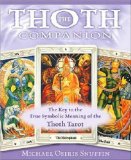
The Thoth Companion: The Key to the True Symbolic Meaning of the Thoth Tarot
, by Michael Osiris Snuffin
Llewellyn Worldwide, 9780738711928, 216 pp. (incl. appendix, glossary, bibliography and index), 2007
The Crowley-Harris Thoth Tarot is perhaps the second most popular tarot deck after the Rider-Waite-Smith. Conceived and executed towards the end of Crowley’s life, the Thoth Tarot distills some fifty years of magickal study and practice. Its densely packed occult symbolism is not easily obtained from his treatise on the subject, Book of Thoth
, as it assumes a high familiarity with a variety of esoteric disciplines. Several books have been written endeavouring to illuminate its significance; The Thoth Companion represents the most recent attempt.
In the introduction Snuffin writes that the purpose of the present book is to “explore the symbolism of the Thoth tarot and provide a comprehensive analysis of the deck. Using materials from the Golden Dawn and Thelemic systems as the basis for analysis, this book will show how the symbols in each card define and shape the meaning of the card as a whole. In addition, it will reveal the complex correspondences and elusive secrets that Crowley encoded within the Thoth tarot.” That said, a certain level of familiarity with the Golden Dawn, Thelema and Crowley’s work is assumed and we’re spared a rehash of various histories and justifications for symbolic authenticity – it’s merely taken for granted.
The book is comprised of four chapters. The first deals with the trumps; each of which is headed with a box giving its Hebrew letter, meaning, astrological or planetary attribution, path on the Tree of Life and which sephira it connects.
Regarding Trump I, The Magus, Snuffin writes “Many Thoth tarot decks come with three different versions of the Magus, allowing the owner to select the trump he finds most desirable. While the three trumps are different in appearance, the general symbolism remains constant, so most of the analysis that follows applies to all three versions.”1 This is a bit of a misnomer.
Only one version of the Magus card was intended for inclusion in the Thoth tarot. As DuQuette explains in Understanding Aleister Crowley’s Thoth Tarot, “The mystery of the three magi of the Thoth Tarot, is no mystery at all. The seventy-eight cards of a standard tarot deck are printed on four sheets of twenty cards per sheet. This provides room for eighty card-size images per print run. Most publishers fill the extra spaces by printing two instructional or promotional cards. Rather than doing that, the Swiss publishers, A.G. Mueller, decided to treat Crowley/Harris aficionados to a little bonus by filling the extra spaces with two earlier versions of the Magus that Harris completed but Crowley rejected.”2 They were never intended to replace or supplement the final version of the card Crowley approved.
The second chapter addresses the court cards, which list their elemental attribution, zodiacal attribution, crest, symbols and a brief description of key concepts related to the card. Following this, a brief description of the symbolism and a list of keywords related to personality traits associated with each card.
The pips, referred to here as the suit cards, are the subject of the third chapter. He’s a bit misleading regarding the origins of the figures on the pips. He writes that “[t]he suit cards of tarot decks published before the twentieth century were usually very simple, showing only the symbol of the suit laid out in a symmetrical pattern. This changed with the publication of the Rider-Waite tarot deck, when Pamela Colman Smith painted each of the suit cards with medieval-style scenes that illustrated her meanings.”3 Usually, yes, but the fifteenth century Italian Sola-Busca, one of the earliest surviving tarot decks, also depicted human figures on its pips. That the Sola-Busca directly inspired many of the scenes painted by Colman Smith is evident in that several figures are represented in exactly the same pose.
The insights offered tend to focus on the Golden Dawn attributions and colour associations in particular, supplemented by Crowley’s writings on the subject and his own reflections. The symbolic analyses are good, but, while it’s clear Snuffin has a respectable grasp of structure, he rarely expounds upon it in a meaningful way.
The fourth and final chapter introduces a basic, practical approach to tarot divination. Formulating a question, shuffling, reading one’s own cards, as well as a few exercises to explore and develop one’s relationship with the cards. An appendix follows with tables of correspondences, and a glossary of key terms, biography and index.
While The Thoth Companion is not a “must have” guide to the Thoth Tarot, it’s not a bad introduction, and those interested using it as a divinatory deck will find it useful.







